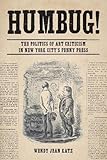Humbug! : The Politics of Art Criticism in New York City's Penny Press / Wendy Jean Katz.
Material type: TextPublisher: New York, NY : Fordham University Press, [2020]Copyright date: ©2020Description: 1 online resource (304 p.) : 68Content type:
TextPublisher: New York, NY : Fordham University Press, [2020]Copyright date: ©2020Description: 1 online resource (304 p.) : 68Content type: - 9780823285402
- Art and society -- New York (State) -- New York -- History -- 19th century
- Art criticism -- New York (State) -- New York -- History -- 19th century
- Art -- Political aspects -- New York (State) -- New York -- History -- 19th century
- Penny newspapers -- New York (State) -- New York
- American Studies
- Art & Visual Culture
- Journalism
- HISTORY / United States / State & Local / Middle Atlantic (DC, DE, MD, NJ, NY, PA)
- American Art
- Antebellum
- Art criticism
- Civil War
- Humbug
- Newspapers
- Penny press
- Political parties
- Politics
- Working-class
- 701/.18 23
- N7476 .K37 2020
- online - DeGruyter
| Item type | Current library | Call number | URL | Status | Notes | Barcode | |
|---|---|---|---|---|---|---|---|
 eBook
eBook
|
Biblioteca "Angelicum" Pont. Univ. S.Tommaso d'Aquino Nuvola online | online - DeGruyter (Browse shelf(Opens below)) | Online access | Not for loan (Accesso limitato) | Accesso per gli utenti autorizzati / Access for authorized users | (dgr)9780823285402 |
Browsing Biblioteca "Angelicum" Pont. Univ. S.Tommaso d'Aquino shelves, Shelving location: Nuvola online Close shelf browser (Hides shelf browser)

|

|

|

|

|

|

|
||
| online - DeGruyter Dynamis of Healing : Patristic Theology and the Psyche / | online - DeGruyter America's Most Famous Catholic (According to Himself) : Stephen Colbert and American Religion in the Twenty-First Century / | online - DeGruyter The Princeton Fugitive Slave : The Trials of James Collins Johnson / | online - DeGruyter Humbug! : The Politics of Art Criticism in New York City's Penny Press / | online - DeGruyter Upper West Side Catholics : Liberal Catholicism in a Conservative Archdiocese / | online - DeGruyter In Praise of Risk / | online - DeGruyter Witnessing Girlhood : Toward an Intersectional Tradition of Life Writing / |
Frontmatter -- Contents -- Illustrations -- Introduction: The Penny Press -- 1. The Aristocracy of Art and Bennett’s Herald -- 2. Artists, Their Agents, and Press Manipulation -- 3. Old Masters versus Young America -- 4. The Penny Press’s Utopian Alternative -- 5. The Genteel and the Bohemian -- 6. Rearing Statues amid Gothic Spires -- Conclusion: Art and Politics -- Acknowledgments -- Notes -- Index -- Select titles from Empire State Editions
restricted access online access with authorization star
http://purl.org/coar/access_right/c_16ec
Approximately 300 daily and weekly newspapers flourished in New York before the Civil War. A majority of these newspapers, even those that proclaimed independence of party, were motivated by political conviction and often local conflicts. Their editors and writers jockeyed for government office and influence. Political infighting and their related maneuvers dominated the popular press, and these political and economic agendas led in turn to exploitation of art and art exhibitions. Humbug traces the relationships, class animosities, gender biases, and racial projections that drove the terms of art criticism, from the emergence of the penny press to the Civil War.The inexpensive “penny” papers that appeared in the 1830s relied on advertising to survive. Sensational stories, satire, and breaking news were the key to selling papers on the streets. Coverage of local politicians, markets, crime, and personalities, including artists and art exhibitions, became the penny papers’ lifeblood. These cheap papers, though unquestionably part of the period’s expanding capitalist economy, offered socialists, working-class men, bohemians, and utopianists a forum in which they could propose new models for American art and society and tear down existing ones.Arguing that the politics of the antebellum press affected the meaning of American art in ways that have gone unrecognized, Humbug covers the changing politics and rhetoric of this criticism. Author Wendy Katz demonstrates how the penny press’s drive for a more egalitarian society affected the taste and values that shaped art, and how the politics of their art criticism changed under pressure from nativists, abolitionists, and expansionists. Chapters explore James Gordon Bennett’s New York Herald and its attack on aristocratic monopolies on art; the penny press’s attack on the American Art-Union, an influential corporation whose Board purchased artworks from living artists, exhibited them in a free gallery, and then distributed them in an annual five-dollar lottery; exposés of the fraudulent trade in Old Masters works; and the efforts of socialists, freethinkers, and bohemians to reject the authority of the past.
Mode of access: Internet via World Wide Web.
In English.
Description based on online resource; title from PDF title page (publisher's Web site, viewed 27. Jan 2023)


